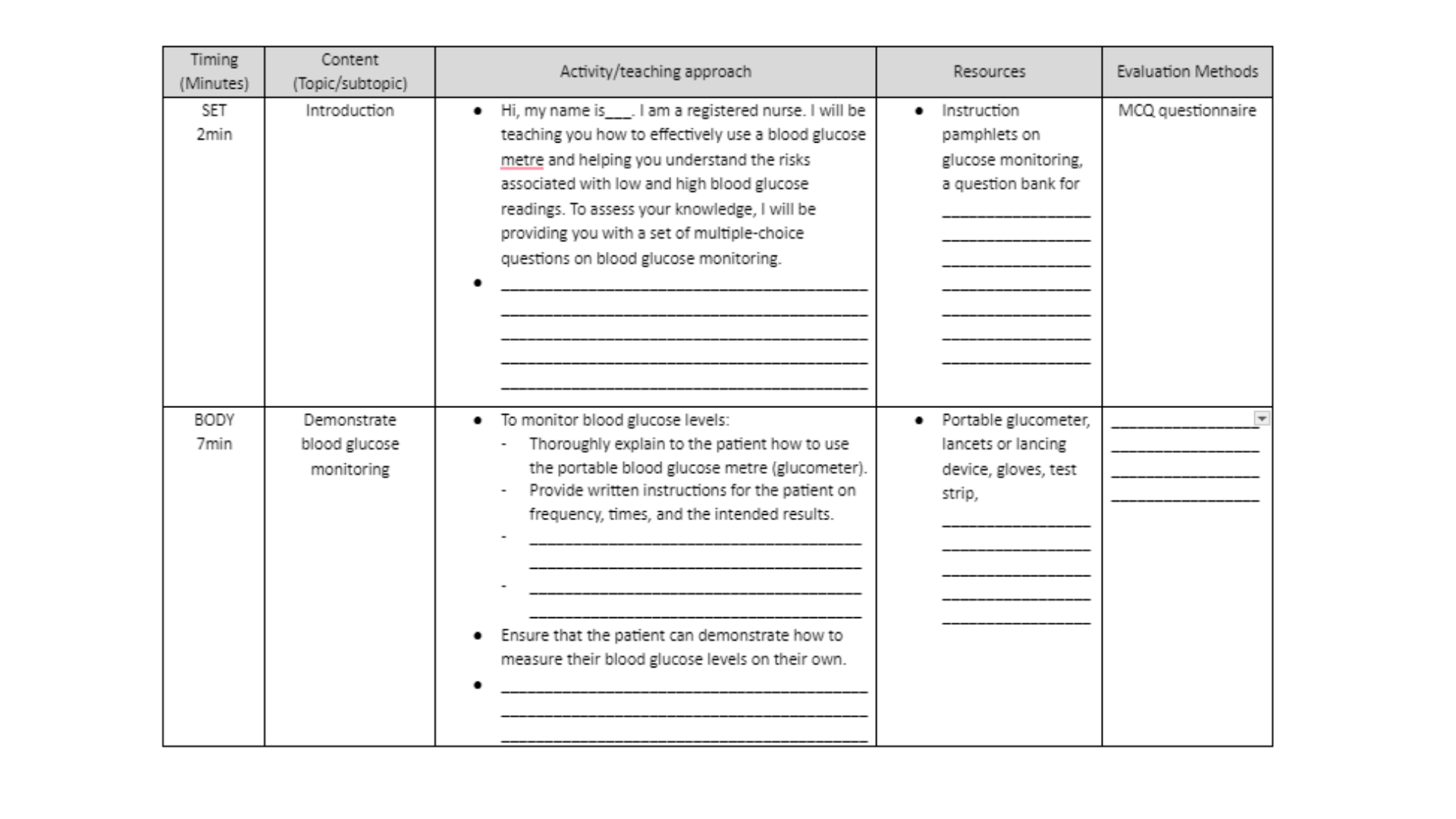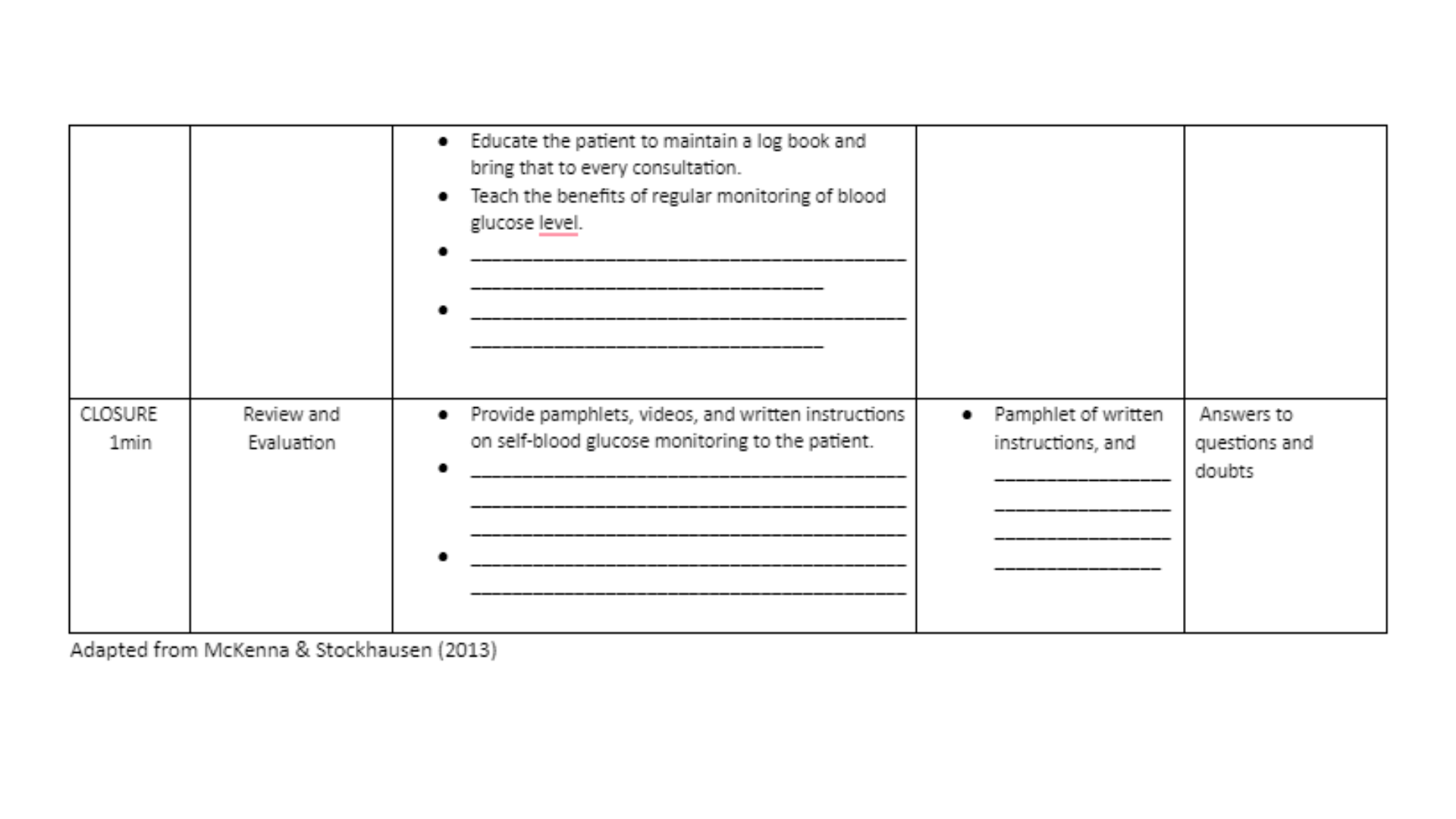NUR5033: Development of a Lesson Plan Assignment Help

Question
NUR5033: This is a Contemporary Nursing assignment for Monash University which demands the student develop a nursing lesson plan to inform a patient Penelope Phillpott about a particular psychomotor skill that is a part of her diabetes management plan. This nursing teaching plan should demonstrate that the student can use research to inform teaching and learning in their nursing practice by creating a lesson plan. The nursing assignment consists of two parts- A written paper and a lesson plan following the template provided in the assessment file.
Solution
The solution to this lesson Plan Assignment consists of a written document elaborating on Mrs. Philpott’s proficiency in self-monitoring her blood glucose levels and the instructions necessary to inform her about the process and significance of routinely measuring and documenting her blood glucose levels using a glucometer.
Written Paper
NUR5033 Lesson Plan Assignment is divided into three sections- Introduction, body, Evaluation and feedback of the teaching plan, and a Summary.
Introduction
While providing help for this Monash University assignment, our experts have written a short yet descriptive introduction to provide a brief background of Mrs. Philpott’s clinical history.
The aim of this paper is to assess the knowledge and skill of Mrs Philpott on self-monitoring of blood glucose levels and to teach her the procedure and importance of regular blood glucose monitoring and recording using a glucometer. As mentioned in the case study, Mrs Philpott is suffering from diabetes and does not have a diabetes management plan, which is the clinical issue in this paper. The paper would first discuss and reason about the teaching-learning setting used to educate Mrs Philpott. After that, it will identify the patient’s readiness for the teaching session.
How do I write a nursing teaching plan? Feeling stuck with your nursing assignment? No worries! Call us to get expert assistance at discounted prices- +61 871501720.
Body
This section presents a supporting rationale behind the chosen teaching-learning environment and the selection of instruction and presentation techniques. Additionally, the determination of the learner’s expected learning needs and preparedness in connection with this teaching session is also explored in the body of this lesson plan assignment for Monash University.
The registered nurse would prefer the patient’s room to educate Mrs Philpott on self-blood glucose monitoring, as the patient has recently undergone a total hip replacement. Therefore, in order to keep Mrs Philpott’s comfortable, the patient’s room would be the most appropriate place to educate. The nurse will teach Mrs Philpott the importance of regular self-monitoring of blood glucose levels by employing the teach-back method. The teach-back method is used in the healthcare industry to ensure that the patient has understood the medical information explained to them (Centrella & Alexander, 2017). It includes asking patients to describe in their own words what a medical professional has just explained. The healthcare professional will then clarify any miscommunications and reassess the patient’s understanding. This procedure is repeated until the patient is able to retain the information provided accurately (Talevski et al., 2020). This method is successful in enhancing patient outcomes and improving patient understanding of diagnosis, prognosis, physical therapy, and accessible treatment options. It is beneficial to employ textual and visual materials such as pamphlets, images, and models to support the concepts of blood glucose monitoring in order to increase patient knowledge (Yen & Leasure, 2019). The teach-back method was used for this patient to ensure that the patient clearly understood the concept of monitoring blood glucose levels independently. To assess the patient’s skill acquisition level, Peyton’s teaching for skill acquisition was utilized. The four steps of Peyton’s stepwise approach to teaching are: Demonstration – in which the nurse would demonstrate the entire process of blood glucose monitoring with the help of a portable glucometer to the patient. Discussion – step-wise explanation while monitoring and discussing the blood glucose level with the patient would be done (Khan, 2020). Comprehension – the patient would describe the process and the nurse would measure her own blood glucose levels by using glucometer. Execution – the patient would demonstrate the entire process of blood glucose monitoring using the glucometer while explaining every step (Giacomino et al., 2020). The patient’s willingness to learn new things and adopt new behaviours is referred to as their learning readiness. The ability of a patient to learn is affected by numerous things (Chakkaravarthy et al., 2018). The patient’s willingness and motivation to learn can be impacted by anything that interferes with their physically or psychological well-being, such as pain, exhaustion, stress, or fear (Patient Education: Learning Readiness, n.d.). The patient does want to learn and take care of themselves. In the case study, Mrs Philpott informs the nurse that she is not eating well and taking care of herself as she should, which shows that the patient is aware and shows a willingness to learn and care about their health. The teach-back method of education is required for this patient as the patient is 78 years old and the likelihood of forgetting the steps or process of self-blood glucose monitoring using a glucometer is quite high.
Searching for the Best assignment writing services in Melbourne? Reach out to OAS today- onlineassignmentservices1@gmail.com.

Evaluation & Feedback
The following section of the nursing teaching plan outlines a mechanism to identify if the learning objectives are being met or not and whether the teaching provided through the lesson plan was received by the patient.
To determine if the patient has met the learning objectives, the nurse will utilise behaviourism theory for an efficient evaluation. This theory places a strong emphasis on observable behaviour as the primary measure of learning (Mukhalalati & Taylor, 2019). The nurse would observe the patient skills and comprehension level on BGLs monitoring. The nurse will utilise formative and summative assessment techniques to assess the effectiveness of teaching. Throughout the entire lesson, the patient will be asked questions in order to assess their understanding as part of formative assessment lesson (ISA& SAIBOON, 2020).
We can help you write your NUR5033 Lesson Plan Assignment. Drop us a text over WhatsApp for qualified assistance- +447700174710.
Summary
Here, a brief summary of all the points mentioned above has been provided by our experts. You can read a snippet of the complete summary written by our experts:
The registered nurse thoroughly explained the procedure of BGL monitoring with the help of a glucometer using the teach-back method. It is used to ensure that the patient has understood the medical information explained to them (Talevski et al., 2020). The nurse demonstrated to the patient the entire process of BGL monitoring with the help of a glucometer, along with a step-by-step explanation. Then Mrs Philpott describes the process, and the nurse measures her own blood glucose levels by using a glucometer.
Looking for Monash University Assignment Help? Let our highly qualified experts assist you. Reach out at onlineassignmentservices1@gmail.com.
Lesson Plan
The second part of this assessment is a lesson plan, which has been developed by our experts through a thorough critical analysis of the case scenario presented to us.


Reach out to us to get assistance from subject matter experts to enhance your Lesson Plan Assignment. Call us at +61 871501720.

Need help with other assignments from this course? Our experts have written other high-quality assignments as well:
- NUR5033: Active Learning Engagement Assignment Help
- NUR5033: Literature Review Assignment Help
